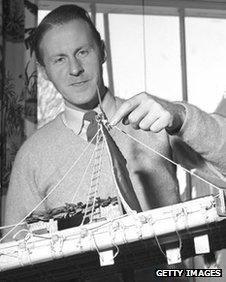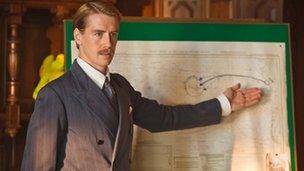Thor Heyerdahl film sets sail to Toronto
- Published

Thor Heyerdahl with a model of his balsa wood craft
In 1947 the Norwegian explorer Thor Heyerdahl led a six-man expedition more than 4,000 miles across the Pacific.
He wanted to prove a scientific theory - but what caught the public imagination was that the men set sail on the Kon-Tiki, a primitive raft whose flimsiness some said made the voyage suicidal.
Now the story has been dramatised for a movie, which is being launched at the Toronto Film Festival this week.
Jeremy Thomas is one of Britain's most successful independent movie producers. His hits have included The Last Emperor and Sexy Beast. But he says he's never laboured at a film as long as Kon-Tiki, which is getting its international premiere in Toronto on Friday.
"It's hard to explain quite how famous Thor Heyerdahl and his raft Kon-Tiki were when I was growing up in the 50s and 60s," he says. "But for a long time it never really occurred to me to try to make a film of his fantastic adventure."
In 1947, Thor Heyerdahl sailed from Peru to the Polynesian islands on a simple balsa wood raft. He wanted to show the voyage would have been possible centuries before with the simple technology then available, disproving the assumption that Polynesia was settled from Asia.
Most anthropologists disagreed with Heyerdahl's thesis then... And they still do.
But it wasn't really the anthropology which fascinated millions of people around the world - it was the adventure.

The production was reportedly Norway's biggest-budget film ever
Thor Heyerdahl's account of the perilous voyage became a best-seller and a documentary film of the expedition won a Oscar in 1951.
The young Jeremy Thomas was among those gripped by a story which could have been written by Jules Verne.
"In 1996 my friend Michael Douglas suddenly mentioned Heyerdahl out of the blue," says Thomas.
"Michael wasn't even sure I'd have heard of him but I explained that I'd grown up with Heyerdahl as a hero. For people of my generation Kon-Tiki was an exciting story. Then Michael told me Heyerdahl's publisher was looking for a film deal. So I went to Tenerife to talk to Thor Heyerdahl."
It's taken Jeremy Thomas sixteen years and at least five screenplays to make the movie. Well-known writers came and went.
"Initially I thought this would be an $80m (£63.4m) Hollywood movie," he says, "and at one point I was sure Leonardo DiCaprio would make a great Heyerdahl. But about three years ago production went up a gear and now we have a different kind of film."
Thomas acknowledges that production grew easier after Heyerdahl's death in 2002 at the age of 87.
"He was a hugely charismatic man who had achieved a lot: He had massive energy even in old age. But he wanted a movie which told his whole life story. That was impossible in dramatic terms."
Thomas says new film technology means the movie is better than it would have been in 1996. "CGI helped a lot, making the Pacific and its sea-life a more exciting part of the story.
"The truth is that often large stretches of water can look flat on camera - computers get round that problem."
A selection of sharks provide some of the story's highpoints, though the producer insists very little has been invented.
A private man
Kon-Tiki, already a hit in Norway, is directed by Norwegians Joachim Roenning and Espen Sandberg, who take a joint credit behind the camera. Their previous film was Max Manus in 2008.
This film is one third in English (including sequences set in the US) and two-thirds in Norwegian, with subtitles. But alternative takes in English exist for all scenes, if that's ultimately what the market demands.
As played convincingly by actor Pal Sverre Hagen, the film portrays Heyerdahl as driven but essentially likeable. Roenning says the explorer was a complex person.
"I suspect Thor Heyerdahl was a very private man, even though he was constantly being interviewed and photographed. I think maybe he was a lonely man too. He came from a small town south of Oslo called Larvik, which is very near where Espen and I grew up.

Pal Sverre Hagen takes the title role. He also starred in the directors' previous film, Max Manus
"His family was prosperous but he felt he had to escape his small-town background - which is pretty much what Espen and I felt too."
Sandberg thinks Heyerdahl was always looking for a calling: "He wanted to find a purpose in life.
"Sometimes people forget that he worked on his theories for 10 years before the Kon-Tiki expedition and he went on exploring and researching for the rest of his life."
Kon-Tiki is the biggest project ever for Scandinavian cinema and it proves the country can do more than moody crime dramas. It was shot in Norway, Sweden, Malta, Bulgaria, Thailand and the Maldives.
In Scandinavia, Heyerdahl remains famous but the rest of the world now remembers him less than it did. Yet Sandberg is certain the story has universal resonance.
"He's an inspiring figure because all of us want adventure in our lives. It's amazing what you can do if you face down your fears.
"You know, Thor Heyerdahl couldn't even swim but he spent 101 days on a raft crossing the Pacific. It's the ultimate adventure story."
Kon-Tiki will be shown at the Toronto International Film Festival on Friday, 7 September.